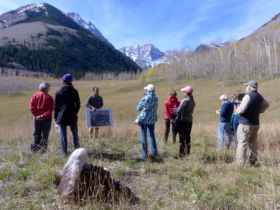Rights tied to potential Maroon, Castle dams
After conferring on the city of Aspen’s applications to extend its conditional water rights tied to potential dams and reservoirs on Maroon and Castle creeks, the division engineer and the water court referee in Division 5 together have raised substantial questions about the two applications.
The two state officials, based in Glenwood Springs, said recently in two required “summary of consultations” that the city “must demonstrate that it will secure permits and land use approvals that are necessary to apply the subject water rights to beneficial use.”
It also said the city needs to show that it “will complete the appropriations within a reasonable time,” that the city has to show that “a specific plan is in place to develop the subject water rights” and that it is “not speculating with the subject water rights.”
Alan Martellaro, the division engineer in Division 5, signed the two “summary of consultations” on Jan. 23. They are identical save for the names of the reservoirs.
Martellaro wrote in both reports, “I cannot recommend approval of this application” until the concerns cited in the reports are addressed.
And the reports say that the “state and division engineers ask that the issues discussed in this consultation be addressed prior to granting any findings of diligence” for either the Maroon Creek or Castle Creek reservoirs.
The city filed two “due diligence” applications on Oct. 31, one for Maroon Creek Reservoir and one for Castle Creek Reservoir. Aspen is seeking to extend the conditional water storage rights for another six years. The rights were appropriated in 1965 and adjudicated in 1971.
The city has filed diligence applications for the reservoirs eight prior times, in 1972, 1977, 1981, 1985, 1989, 1995, 2002 and 2009, and each time has been awarded a new diligence decree for the conditional rights.
The conditional rights, as currently decreed, cannot be made absolute unless the city builds a dam 155 feet tall and an estimated 1,280 feet wide across Maroon Creek, within view of the Maroon Bells, and a dam 170 feet tall and an estimated 1,220 feet wide across upper Castle Creek two miles below Ashcroft.
The Maroon Creek Reservoir would hold 4,567 acre-feet of water and flood 85 acres of land, and the Castle Creek Reservoir would hold 9,062 acre-feet of water and flood 120 acres of land. Water in both reservoirs would flood some land within the wilderness boundary.
Members of the city council indicated this fall said they are loath to actually build the dams, but still want to maintain the water rights for future potential use.
However, the language in the applications the city filed with water court in October indicates the city intends to build the dams some day.
The city told the court the two reservoirs are “part of Aspen’s integrated water supply system” and are “part of Aspen’s long-range plan to maintain a water supply to meet current and future demand.”
The city also said it has “steadily applied effort to complete the appropriation” of the water rights for the reservoirs and that it has done so “in a reasonably expedient and efficient manner under all the facts and circumstances.”
But the consultation reports in the two cases show that state water officials are skeptical about the city’s claims.
Aspen “is not entitled to an exemption from the anti-speculation doctrine” and “it cannot assert issue or claim preclusion to avoid the ‘can and will’ and the ‘anti-speculation’ doctrines,” the reports say.
The reports also observe that the city lists “other beneficial uses, both consumptive and non consumptive” in its water right application, in addition to storage. And as such, the city “must explain what these ‘other’ uses are or they should be cancelled by the court as speculative.”
Many of the points raised in the consultation reports were also raised by some of the 10 opponents to the city’s applications in their statements of opposition.
The United States of America, on behalf of the U.S. Forest Service, and Pitkin County are among the 10 parties that have filed statements of opposition in the two cases.
In addition to the two governments, four environmental organizations and four private-property owners also filed statements of opposition in the cases.
Attorneys at the U.S. Justice Department told the court the city “cannot show that it can and will” complete the two reservoirs “within a reasonable time” because both potential reservoirs would flood portions of the Maroon Bells-Snowmass Wilderness.
And Pitkin County told the court the city “appears to be speculating with no reasonable demonstration of need” for the reservoirs.
It is standard procedure in Division 5 water court for applicants to eventually file a “response to the summary of consultation.”
Relevance of consultations
Under Colorado law, the water court referee and the division engineer are required to review all applications to water court.
But it is sometimes hard to discern how much weight such a report carries in the water court process.
Holly Strablizky, who recently stepped down from her position as water court referee in Division 5 after almost seven years, said last week during a presentation at the Colorado Water Congress that as water referee she “really tried hard and I know our division engineer tried really hard as well … to use the consultation process to get a better product out there.”
Strablizky, who is now an assistant county attorney for Eagle County, said the engineer and the referee also need to look at a given application from a statewide perspective.
“The constitution really says that we as the water court need to think not only of the parties that are in the cases, but the people of Colorado,” Strablizky said.
She also praised the use of the water court referee process, where parties are encouraged to settle their differences.
“I think it relieves pressure of hard deadlines and it allows for thoughtful and creative settlement discussions,” Strablizky said of the referee period, which usually lasts 12 to 18 months. “And it creates that opportunity for concise, and understandable, proposed decrees.”
The parties in Aspen’s two conditional water rights cases are set to have a joint initial telephone conference the new water court referee, Susan Ryan, on Feb. 9.
In addition to participating in the two water rights cases regarding due diligence, the city is also launching a community-based water planning effort, and has signed a flurry of contracts to study its storage needs and better understand at least the potential Castle Creek Reservoir location.
It also not retreating from its call to build a new dam somewhere in the future.
In a memo about a Jan. 31 work session, city staff wrote, “Without water storage, Aspen’s water supply for households and businesses will be threatened.”
To move its new water-planning process forward the city has a entered into a contract with the Consensus Building Institute of Cambridge, Mass. to develop a “convening assessment” that will lead to a “collaborative process.”
“It is critical to use an effective community-based approach in order to leverage the expertise in the community and develop a long-term water supply plan with the greatest chance of success to secure Aspen’s water future,” the city’s memo states.
The convening assessment is expected to take two months and then a collaborative process will begin by summer.
Editor’s note: Aspen Journalism and the Aspen Daily News are collaborating on coverage of rivers and water. This story has been edited for space. To read it in its entirety, go to www.aspenjournalism.org


